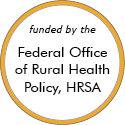Rural Project Examples: Health conditions
Evidence-Based Examples
Chronic Disease Self-Management Program
Updated/reviewed November 2025
- Need: To help people with chronic conditions learn how to manage their health.
- Intervention: A small-group 6-week workshop for individuals with chronic conditions to learn skills and strategies to manage their health.
- Results: Participants have better health and quality of life, including reduction in pain, fatigue, and depression.
Fit & Strong!®
Updated/reviewed November 2025
- Need: Osteoarthritis is a chronic condition which often causes multiple related disabilities in older adults.
- Intervention: An evidence-based curriculum incorporating physical activity, behavior change, and fall prevention geared to older adults with lower extremity osteoarthritis.
- Results: Participants experienced less stiffness, improved joint pain, improved lower extremity strength and mobility, in addition to creating their own unique program for continued post-class use.
Mental Health First Aid
Updated/reviewed August 2025
- Need: Rural areas face challenges in access to mental health services, including shortages of mental health providers.
- Intervention: This 8-hour course trains rural community members to recognize mental health and substance use issues and learn how to help someone who is developing a mental health concern or experiencing a mental health crisis.
- Results: Numerous studies of this method have found that course participants are better able and more likely to help others regarding mental health issues.
Project ENABLE (Educate, Nurture, Advise, Before Life Ends)
Updated/reviewed May 2025
- Need: To enhance palliative care access to rural patients with serious illness, such as advanced cancer, heart failure, and COPD, and their family caregivers.
- Intervention: Project ENABLE consists of: 1) an initial in-person palliative care consultation with a specialty-trained provider and 2) a semi-structured series of weekly, phone-delivered, nurse-led or palliative care coach/navigator sessions designed to help patients and their caregivers enhance their problem-solving, symptom management, and coping skills.
- Results: Patients and caregivers report higher quality of life and lower rates of depression and (caregiver) burden.
Telepsychology-Service Delivery for Depressed Elderly Veterans
Updated/reviewed April 2025
- Need: To provide evidence-based psychotherapy for depression in elderly veterans who are unable to seek mental health treatment due to distance or stigma.
- Intervention: Telepsychology-Service Delivery for Depressed Elderly Veterans compared providing behavioral activation therapy via home-based telehealth and the same treatment delivered in a traditional office-based format.
- Results: A 2015 study and two 2016 studies show that providing treatment via home-based telehealth to elderly veterans in South Carolina resulted in the same improved health outcomes, quality of life, satisfaction with care, and cost of healthcare compared to those receiving face-to-face treatment.
StrongPeople® Program
Updated/reviewed July 2024
- Need: Few older adults, particularly women and those in rural areas, participate in healthy living interventions.
- Intervention: Health educators lead community-based healthy living classes, which include strength training, aerobic exercise, dietary skill building, and/or civic engagement, depending on the program.
- Results: StrongPeople® programs have been shown to improve weight, diet, physical activity, strength, cardiovascular health profile, physical function, pain, depression, and/or self-confidence in midlife and older adults.
Project ECHO® – Extension for Community Healthcare Outcomes
Updated/reviewed February 2024
- Need: Increase medical management knowledge for New Mexico primary care providers in order to provide care for the thousands of rural patients with hepatitis C, a chronic, complex condition that has high personal and public health costs when left untreated.
- Intervention: Project leveraging an audiovisual platform to accomplish "moving knowledge, not patients" that used a "knowledge network learning loop" of disease-specific consultants and rural healthcare teams learning from each other and learning by providing direct patient care.
- Results: In 18 months, the urban specialist appointment wait list decreased from 8 months to 2 weeks due to Hepatitis C patients receiving care from the project's participating primary care providers. Improved disease outcomes were demonstrated along with cost savings, including those associated with travel. The project model, now known as Project ECHO® – Extension for Community Healthcare Outcomes — has evolved into a telementoring model used world-wide.
Effective Examples
Health Coaches for Hypertension Control

Updated/reviewed November 2025
- Need: A cost-effective approach to help rural patients with hypertension learn to manage their condition.
- Intervention: Community volunteers trained as health coaches provided an 8-session hypertension management training program to hypertension patients older than 60, with an optional supplemental 8 sessions focused on nutrition and physical activity.
- Results: Just 16 weeks after the program, participants had improved systolic blood pressure, weight, and fasting glucose, greater knowledge of hypertension, and improved self-reported behaviors.
Kentucky Homeplace
Updated/reviewed October 2025
- Need: Rural Appalachian Kentucky residents have deficits in health resources and health status, including high levels of cancer, heart disease, hypertension, asthma, and diabetes.
- Intervention: Kentucky Homeplace was created as a community health worker initiative to provide health coaching, increased access to health screenings, and other services.
- Results: From July 2001 to June 2025, over 202,000 rural residents were served. Preventive health strategies, screenings, educational services, and referrals are all offered at no charge to clients.
The Pacific Care Model: Charting the Course for Non-communicable Disease Prevention and Management
Updated/reviewed October 2025
- Need: The U.S. Associated Pacific Islands (USAPI) needed an efficient, effective, integrated method to improve primary care services that addressed the increased rates of non-communicable disease (NCD), the regional-specific phrase designating chronic disease.
- Intervention: Through specialized training, multidisciplinary teams from five of the region's health systems implemented the Chronic Care Model (CCM), an approach that targets healthcare system improvements, uses information technology, incorporates evidence-based disease management, and includes self-management support strengthened by community resources.
- Results: Aimed at diabetes management, teams developed a regional, culturally-relevant Non-Communicable Disease Collaborative Initiative that addresses chronic disease management challenges and strengthens healthcare quality and outcomes.
For examples from other sources, see:
